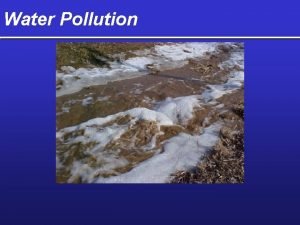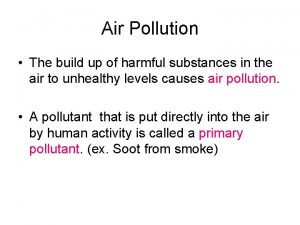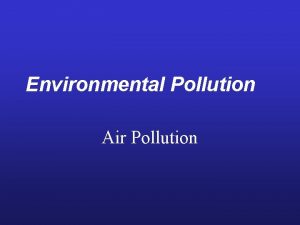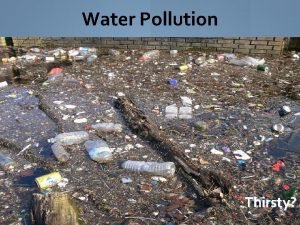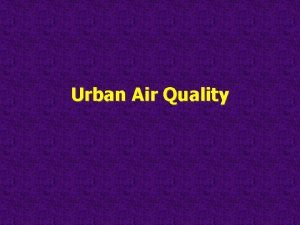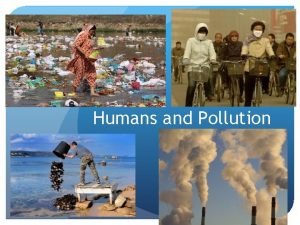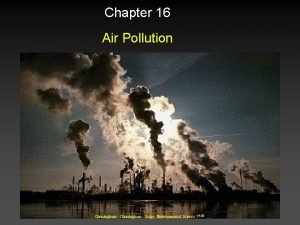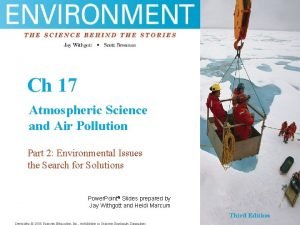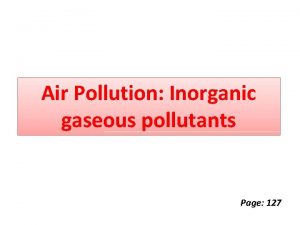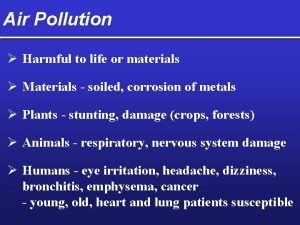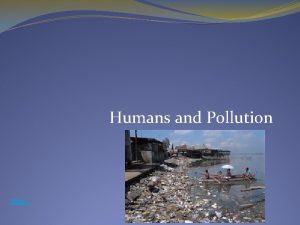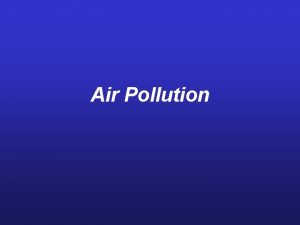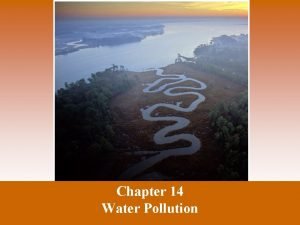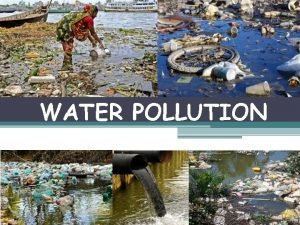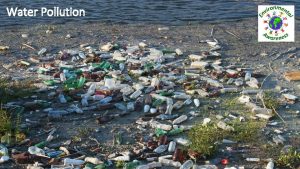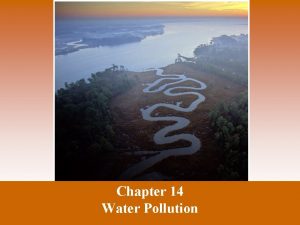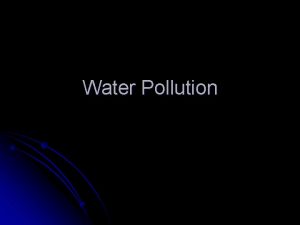Review Water Pollution Major Water Pollutants 1 Human











- Slides: 11

Review Water Pollution

Major Water Pollutants 1. Human wastewater: sewage & gray water • Decomposition of organic waste → Huge O 2 demand • Excess nutrients (N & P) eutrophication • Disease-causing organisms (esp. E. Coli & Cholera) 2. Metals (Pb, Hg, As, Cd) 3. Acid – rain, deposition, runoff 4. Synthetic Organics (pharma; pesticides; Military & Industrial compounds) 5. Oil 6. Solid Waste (especially plastic!) 7. Sediment - erosion - turbidity 8. Thermal & Noise pollution

• Water Pollution: • Point Sources - Discharge pollution from specific locations (single point). EASY TO MONITOR/REGULATE • Effluent • Factories, power plants, oil wells • Non-Point Sources - Scattered or diffuse, having no specific location of discharge. HARDER TO CONTROL!! • Agricultural fields, feedlots, golf courses

Disinfect: Chlorine Ozone U. V. light Primary sewage treatment: a physical process that uses screens and a grit tank to remove large floating objects and allows settling. Tertiary Step Usually not present Expensive Added to remove specific pollutant usually N & P Secondary sewage treatment: a biological process in which aerobic bacteria remove as much as 90% of dissolved and biodegradable, oxygen demanding organic wastes. • .

Water Quality Indicators • Know your list – be able to give examples / sources / causes / effects • N&P • Biodiversity: macroinvertebrates, fish, plants, amphibians, algae, bacteria • DO / BOD / CO 2 • Fecal coliform – indicator • Temp • Turbidity • Heavy metal / p. H – how linked? • Color / odor • Synthetic Organic Compounds – Pesticides • Gender benders • • Pharmaceuticals – antibiotics, hormones Ammonia Chlorine Hardness

Eutrophication • Natural vs. Cultural • Oligotrophic: nutrient-poor water • Eutrophic: nutrient-rich water • Sources - agricultural runoff (fertilizer, feedlots), detergents (P only), disturbed soil, products of decomposition (so any organic matter) • Indicators • Elevated N and P levels • Decreased DO levels, increased BOD levels • Cloudy water: from algae and cyanobacteria • Effects – Eutrophication nutrients ↑, algae grows, blocks sunlight, dies and decomposes, O 2 ↓ • Dead zones

Gulf of Mexico Dead Zone Worst in summer Affects fish & shrimp harvests

Milk Lab Be able to describe in detail what happened & why Farm or animal feedlot Be able to describe impact of runoff

Oxygen Sag Curve A. Clean Zone • DO high • BOD low demand B. Pollution enters stream C. Decomposition Zone • DECOMPOSITION increases to break down pollution • OXYGEN decreases as it is used up by decomposers D. Septic zone – DEAD ZONE - Hypoxic • dissolved oxygen levels are very low and very few species can survive E. Recovery Zone • Waste concentrations decrease • DO � , BOD � F. Clean Zone • DO is high, BOD is low and normal biodiversity levels are present.

Clean Water Act - 1977 • EPA to set water quality standards for industry and for all contaminants in surface waters • regulates discharges of pollutants in the US - point sources • Requires a permit to discharge any pollutant into a navigable waterway. • Goal: Make lakes & streams fishable & swimmable • sets daily limits for total pollutant discharges • Total Maximum Daily Load (TMDL)

Safe Drinking Water Act - 1974 • established to protect the quality of drinking water in the U. S • All waters designed for drinking use - above ground or underground sources • EPA sets Maximum Contaminant Levels (MCLs) for drinking water • Standards for dozens of contaminants
 Planting more trees is called
Planting more trees is called Primary pollutants and secondary pollutants
Primary pollutants and secondary pollutants Secondary air pollutants
Secondary air pollutants Major air pollutants
Major air pollutants Non-point source pollution
Non-point source pollution Water and water and water water
Water and water and water water Secondary pollutants examples
Secondary pollutants examples Primary and secondary pollutants
Primary and secondary pollutants Primary vs secondary pollution
Primary vs secondary pollution Copyright
Copyright Inorganic gaseous pollutants of air
Inorganic gaseous pollutants of air What is secondary pollutant
What is secondary pollutant
